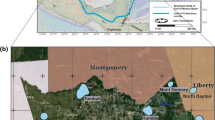Abstract
The complex geological conditions in doubly complex areas tend to result in difficult surface survey operations and poor target layer imaging in the subsurface which has a great impact on seismic data quality. In this paper, we propose an optimal crooked line survey method for decreasing the surface survey operational difficulties and improving the sub-layer event continuity. The method concentrates on the surface shooting conditions, first, selecting the proper shot positions based on the specific surface topographic features to reduce the shot difficulties and then optimizing the receiver positioning to meet the prerequisite that the subsurface reflection points remain in a straight line. Using this method cannot only lower the shooting difficulty of rough surface condition areas but also overcome the subsurface reflection point bending problem appearing in the traditional crooked line survey method. On the other hand, we use local infill shooting rather than conventional overall infill shooting to improve sublayer event continuity and uniformity with lower survey operation cost. A model has been calculated and processed with the proposed optimal crooked line survey and local infill shooting design method workflow and the results show that this new method can work for seismic surveys in double complex areas.
Similar content being viewed by others
References
Deng, F., and Liu, C. Y., 2006, 3-D rapid ray-tracing and Gaussian ray-beam forward simulation: Oil Geophysical Prospecting (in Chinese), 25(6), 93–97.
Dong, L. G., Ma, Z. T., Cao, J. Z., and Wang, H. Z., 2000, A staggered-grid high-order difference method of one-order elastic wave equation: Chinese Journal of Geophysics.(in Chinese), 43(3), 411–418.
Gibson, R. L., Jr., and Tzimeas, C., 2002, Quantitative measures of image resolution for seismic survey design: Geophysics, 67(6), 1844–1852.
Li, W. W., 2008, Design of seismic geometry based on wave equation forward simulation: Oil Geophysical Prospecting (in Chinese), 43(2), 134–141.
Liner, C. L., Underwood, W. D., and Gobeli, R., 1999, 3-D seismic survey design as an optimization problem: The Leading Edge, 18(9), 1054–1060.
Morrice, D. J., Kenyon, A. S., and Beckett, C. J., 2001, Optimizing operations in 3-D land seismic surveys: Geophysics, 66(6), 1818–1826.
Regone, C. J., 2007, Using 3D finite-difference modeling to design wide-azimuth surveys for improved subsalt imaging: Geophysics, 72(5), 231–239.
Sun, W. J., Fu, L. Y., and Wan, X. J., 2007, Phase encodingbased seismic illumination analysis: Oil Geophysical Prospecting (in Chinese), 42(5), 539–543.
Vermeer, G. J. O., 2003, 3-D seismic survey design optimization: The Leading Edge, 22(10), 934–941.
Wang, X. C., and Liu, X. W., 2007, 3-D acoustic wave equation forward modeling with topography: Applied Geophysics, 4(1), 8–15.
Xiong, X. J., He, Z. H., Wen, X. T., and Huang, D. J., 2007, Design of seismic layout based on a wave equation: Journal of China University of Mining and Technology (in Chinese), 36(1), 132–136.
Zhao, D. D., Zheng, Z. J., Lv, G. H., and Tan, S. Q., 2001, Seismic acquisition technique for high-resolution: Oil Geophysical Prospecting (in Chinese), 36(3), 263–271.
Author information
Authors and Affiliations
Additional information
This work was funded by the National Basic Research program of China (973 Program) (No. 2009CB219403), Applied Basic Research Project of CNPC (No: 2011B-3706), School Fund of SWPU, and Earth Exploration and Information Technology of Sichuan Provincial Key Disciplines Construction Program.
Zhao Hu, Lecturer, received his MS in the China University Mining and Technology in 2007 and currently or his PhD in the Chengdu University of Technology. His research interests are seismic survey methods and reservoir prediction. He also works in the Resources and Environment Department of Southwest Petroleum University.
Rights and permissions
About this article
Cite this article
Zhao, H., Yin, C., Wu, MS. et al. Research on seismic survey design for doubly complex areas. Appl. Geophys. 9, 279–285 (2012). https://doi.org/10.1007/s11770-012-0326-4
Received:
Revised:
Published:
Issue Date:
DOI: https://doi.org/10.1007/s11770-012-0326-4



